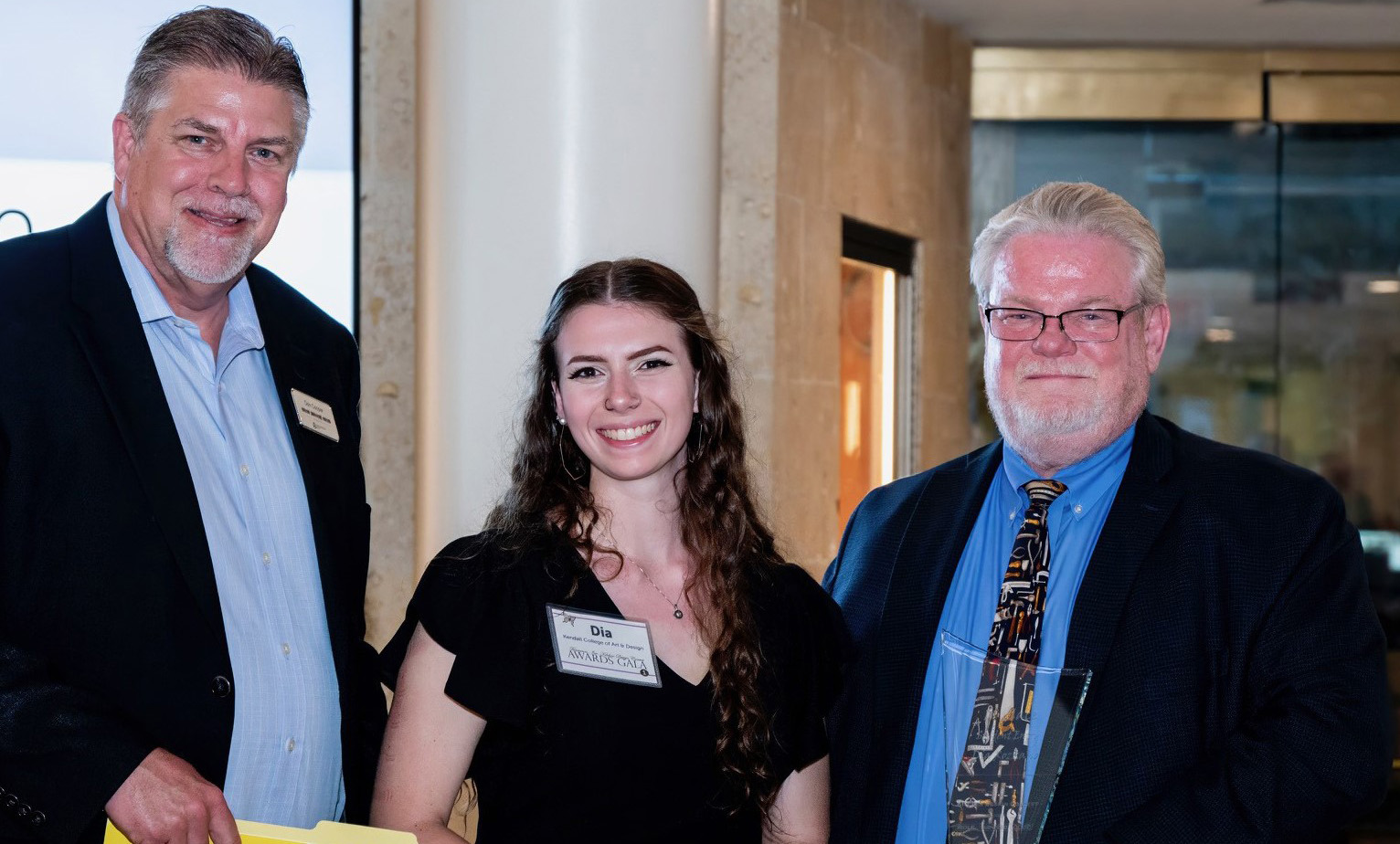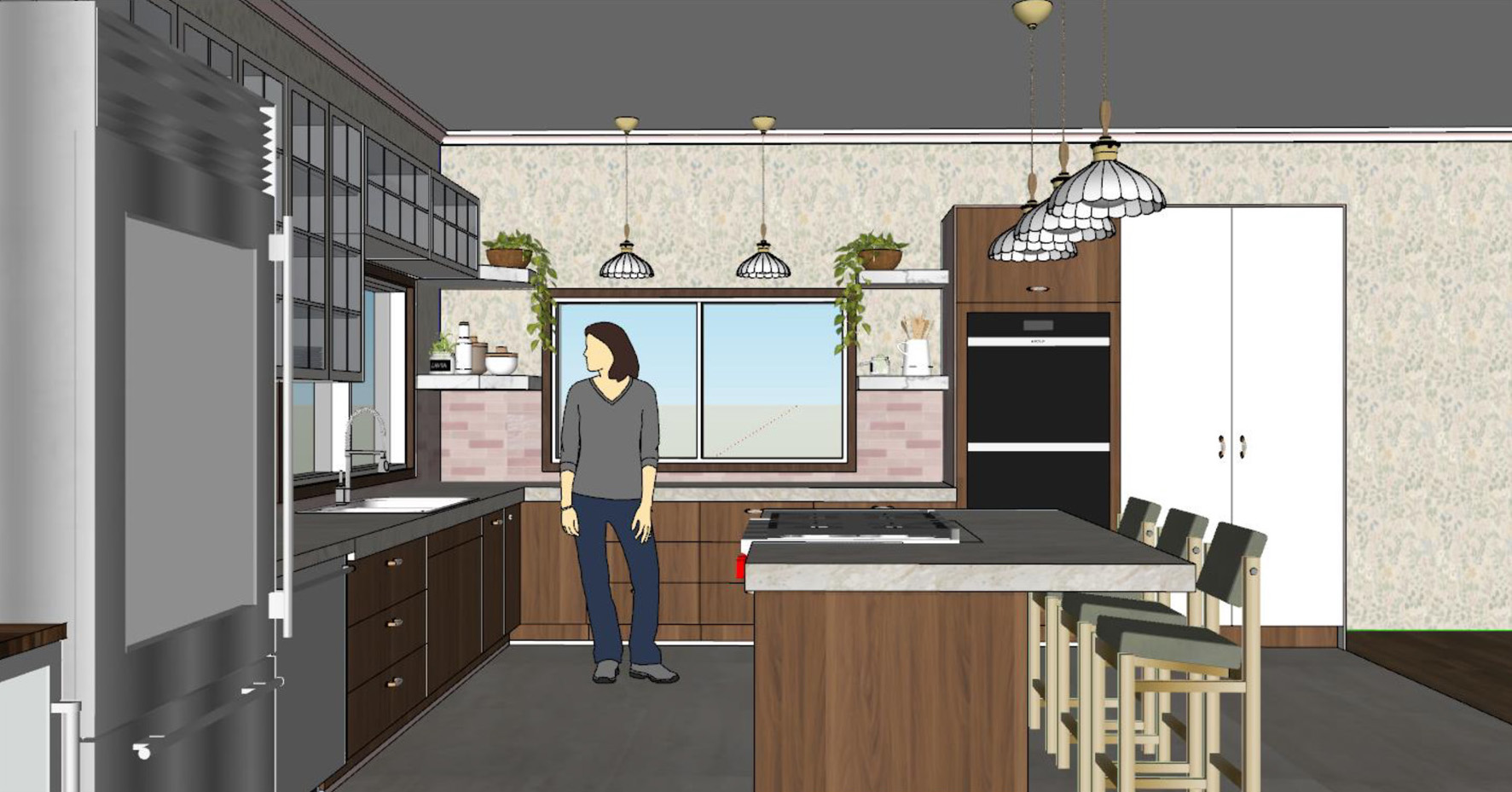Aug. 26, 2024
KCAD Interior Design student Dia Rozzano takes top student prize in 2024 Trevarrow Michigan Kitchen Design Contest

The sky typically isn’t the limit when it comes to kitchen design, but when it is, it pays to know how to make the most of the opportunity.

Dia Rozzano's design from her presentation. This is the Vermont Escape kitchen west view.
Kendall College of Art and Design of Ferris State University Interior Design student Dia Rozzano recently won top state-level honors in the student division of the 2024 Kitchen Design Contest hosted by Trevarrow, Inc., a Michigan-based distributor of high-end kitchen appliance brands Wolf, Cove, and Sub-Zero.
Entrants were challenged to create a hand-drawn or 3D rendered kitchen design that demonstrated skillful integration of form, function, and space use, with the only required parameter being the use of Wolf appliances throughout.
Rozzano wowed the judging panel of industry professionals with her concept of an open kitchen overlooking the Vermont countryside, earning a $1,000 prize and a trip to Detroit for the competition’s award ceremony, where she had the chance to network with industry reps and fellow designers.
“I was just in awe of the whole experience,” Rozzano said. “It was amazing to be surrounded by all these talented people, and to be honored there as a student was a surreal moment that I will never forget.”
To stand out from the competition, Rozzano went far above and beyond the scope of the challenge. She drew on her specialized learning experiences at KCAD to lay the groundwork for her design, developing an entire user case study and material spec list that more closely resembled the work of a seasoned professional than a student project.
Rozzano’s case study envisioned a family in rural Vermont looking to transform their kitchen into a highly functional space with a relaxing atmosphere conducive to gathering and enjoying the surrounding nature.
“I wanted the space to have an open layout but also a cozy, feminine feel that would invite connection,” she said. “I used muted colors and natural wood throughout and made sure there was plenty of natural light and a view from the sink into a spacious backyard.”
Maintaining openness while packing the kitchen full of amenities was no straightforward task. Rozzano’s test case also positioned the space between the home’s living and dining rooms. Both challenges required creative spatial planning and clever design to solve.
An included pantry and wet bar were designed as hidden elements, preserving the clean, uncluttered look of the space and the flow of foot traffic to and from adjacent rooms. Rozzano also selected Wolf appliances that would integrate seamlessly into the cabinetry.
“It was the family’s primary kitchen, so I had to make sure all the necessities were included without losing that feel I was going for,” she said. “Having high end products that I could use however I wanted created some unique possibilities.”
Rozzano credits her success to the Interior Design program’s emphasis on approaching projects from a holistic framework that gives equal weight to the function, aesthetic appeal, and user experience of interior environments.
“I pulled so much from the work I’ve done in class for this competition,” she said. “Our professors always encourage us to begin from a systemic understanding of a project.”
Being able to solve complex, layered design problems using a human-centered process is something program chair and assistant professor Mary Ellen Fritz sees as vital to professional success in today’s interior design landscape.
“We challenge our students to consider function and client needs first, and then leverage their knowledge of both design history and current industry trends to create strong solutions,” Fritz said. “Dia jumped into this opportunity with both feet and crushed it with a lot of hard work. We're so proud of her!”
On top of immersive professional experiences like the Trevarrow competition, Rozzano has been preparing for her career through an internship with Grand Rapids-based architecture and interior design firm Via Design. Over the past year she’s advanced from working part-time in the firm’s resource library to a full-time position this summer that’s had her taken on a higher level of design responsibility.
“I’ve been working more closely with the design team pulling samples and supporting projects,” she said. “It’s been great to see the industry from the inside. There’s learning that happens in this environment that can’t happen the same way in school, so it’s been a valuable experience.
Rozzano hopes to land a full-time role with Via once she graduates and sees a world of opportunity on the horizon.
“I’ve really found a love for residential design in this internship, and it’s been such a formative learning experience that I know I want to be able to give back to students in a similar way throughout my career,” she said. “Wherever design take me, I know I’ll find a place.”

